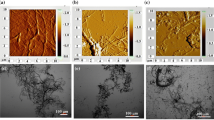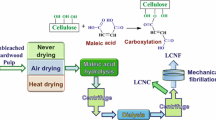Abstract
Having the advantages of a higher yield, lower cost and less environmental impact, lignin-containing cellulose nanofibrils (LCNFs) obtained by mechanically fibrillating unbleached pulps have been demonstrated to be a promising alternative to high-purity nanocellulose. In this study, the structural changes after four drying methods containing freeze-drying (FD), oven-drying (OD), centrifugal followed by vacuum-drying (CVD), and evaporation followed by vacuum-drying (EVD), and efficient reuse of LCNFs were extensively explored. It was found that the structural characteristics of LCNFs after drying were maintained by freeze drying with high lignin contents where the aggregation of fibrils was alleviated by lignin. The freeze-dried LCNFs were further redispersed by homogenizer in water, which exhibited excellent dispersion characteristics. In addition, the redispersed LCNFs were further assembled into PVA films to fabricate high-strength composites. The results showed that when the addition of redispersed LCNFs was up to 16.9%, the tensile strength and elongation at break of the as-prepared composite film increased by 325.2% and 335.2%, respectively. This study demonstrated a more sustainable approach to utilize LCNFs to produce biomass-based composite films than those of CNF-based composite films.
Graphical abstract










Similar content being viewed by others
References
Butchosa N, Zhou Q (2014) Water redispersible cellulose nanofibrils adsorbed with carboxymethyl cellulose. Cellulose 21(6):4349–4358
Cao WH, Li J, Martí-Rosselló T et al (2019) Experimental study on the ignition characteristics of cellulose, hemicellulose, lignin and their mixtures. J Energy Inst 92(5):1303–1312. https://doi.org/10.1016/j.joei.2018.10.004
Chen YM, Wang Y, Wan JQ et al (2009) Crystal and pore structure of wheat straw cellulose fiber during recycling[J]. Cellulose 17(2):329–338
Chen Y, Fan DB, Han YM et al (2018) Effect of high residual lignin on the properties of cellulose nanofibrils/films. Cellulose 25(11):6421–6431
Coleman JN, Cadek M, Blake R et al (2004) High performance nanotube-reinforced plastics: understanding the mechanism of strength increase[J]. Adv Funct Mater 14(8):791–798. https://doi.org/10.1002/adfm.200305200
Ding QJ, Zeng JS, Wang B et al (2018) Effect of retention rate of fluorescent cellulose nanofibrils on paper properties and structure. Carbohyd Polym 186:73–81
Dizhbite T, Telysheva G, Jurkjane V et al (2004) Characterization of the radical scavenging activity of lignins—natural antioxidants. Bioresour Technol 95:309–317
Fu HC, Gao WH, Wang B et al (2019) Effect of lignin content on the microstructural characteristics of lignocellulose nanofibrils. Cellulose 27(3):1327–1340
Gao WH, Chen KF, **ang ZY et al (2013) Kinetic study on pyrolysis of tobacco residues from the cigarette industry. Ind Crops Prod 44:152–157
Gregg SJ, Sing KSW (1982) Adsorption surface area and porosity [M], 2nd edn. Academic Press, London
Gregorova A, Košíková B, Staško A (2007) Radical scavenging capacity of lignin and its effect on processing stabilization of virgin and recycled polypropylene. J Appl Polym Sci 106:1626–1631. https://doi.org/10.1002/app.26687
Grüneberger F, Künniger T, Zimmermann T et al (2014) Rheology of nanofibrillated cellulose/acrylate systems for coating applications. Cellulose 21(3):1313–1326
Hanif Z, Jeon H, Tran TH et al (2017) Butanol-mediated oven-drying of nanocellulose with enhanced dehydration rate and aqueous re-dispersion. J of Polym Res 25(3):191
Huang DY, Wu M, Wang C et al (2020) Effect of partial dehydration on freeze-drying of aqueous nanocellulose suspension. ACS Sustain Chem Eng 8(30):11389–11395
Jiang F, Hsieh YL (2014) Assembling and redispersibility of rice straw nanocellulose: effect of tert-butanol. ACS Appl Mater Interfaces 6(22):20075–20084
Jiang Y, Liu XY, Yang Q et al (2018) Effects of residual lignin on mechanical defibrillation process of cellulosic fiber for producing lignocellulose nanofibrils. Cellulose 25(11):6479–6494
Kwak HW, You J, Lee ME et al (2019) Prevention of cellulose nanofibril agglomeration during dehydration and enhancement of redispersibility by hydrophilic gelatin. Cellulose 26(7):4357–4369. https://doi.org/10.1007/s10570-019-02387-z
Lanzalunga O, Bietti MJ (2000) Photo- and radiation chemical induced degradation of lignin model compounds. J of Photochem and Photobiol B 56:85–108
Lei ZH, Wang SD, Fu HC et al (2019) Thermal pyrolysis characteristics and kinetics of hemicellulose isolated from camellia oleifera shell. Bioresour Technol 282:228–235
Li JP, Wang B, Ge Z et al (2019) Flexible and hierarchical 3D interconnected silver nanowires/cellulosic paper-based thermoelectric sheets with superior electrical conductivity and ultrahigh thermal dispersion capability. ACS Appl Mater Interfaces 11(42):9088–39099. https://doi.org/10.1021/acsami.9b13675
Li PF, Zeng JS, Wang B et al (2020) Waterborne fluorescent dual anti-counterfeiting ink based on Yb/Er-carbon quantum dots grafted with dialdehyde nano-fibrillated cellulose. Carbohyd Polym 247:116721
Lu J, Askeland P, Drzal LT (2008) Surface modification of microfibrillated cellulose for epoxy composite applications[J]. Polymer 49(5):1285–1296
Mathew AP, Thielemans W, Dufresne A (2008) Mechanical properties of nanocomposites from sorbitol plasticized starch and tunicin whiskers[J]. J Appl Polym Sci 109(6):4065–4074. https://doi.org/10.1002/app.28623
Mo WX, Ke K, Shen XN et al (2020) The influence of “thermal drying pretreatment” on enzymatic hydrolysis of cellulose and xylan in poplar fibers with high lignin content. Carbohyd Polym 228:115400
Peng YC, Gardner DJ, Han Y (2011) Drying cellulose nanofibrils: in search of a suitable method. Cellulose 19(1):91–102
Peng Y, Nair SS, Chen HY et al (2018) Effects of lignin content on mechanical and thermal properties of polypropylene composites reinforced with micro particles of spray dried cellulose nanofibrils. ACS Sustain Chem Eng 6:11078–11086
Roohani M, Habibi Y, Belgacem NM et al (2008) Cellulose whiskers reinforced polyvinyl alcohol copolymers nanocomposites[J]. Eur Polym J 44(8):2489–2498
Silva LE, Dos Santos AA, Torres L et al (2021) Redispersion and structural change evaluation of dried microfibrillated cellulose. Carbohyd Polym 252:117165
Siró I, Plackett D (2010) Microfibrillated cellulose and new nanocomposite materials: a review[J]. Cellulose 17(3):459–494
Velasquez-Cock J, Gomez HB, Posada P et al (2018) Poly (vinyl alcohol) as a cap** agent in oven dried cellulose nanofibrils. Carbohyd Polym 179:118–125
Wang FK, Akimov YA, Khoo EH et al (2015) π-π interactions mediated self-assembly of gold nanoparticles into single crystalline superlattices in solution. RSC Adv 5:90766–90771. https://doi.org/10.1039/C5RA17628J
Wang QQ, Yao Q, Liu J et al (2019) Processing nanocellulose to bulk materials: a review. Cellulose 26(13–14):7585–7617
Wu ZN, Liu JL, Li YC et al (2015) Self-assembly of nanoclusters into mono-, few-, and multilayered sheets via dipole-induced asymmetric van der Waals attraction. ACS Nano 9:6315–6323. https://doi.org/10.1021/acsnano.5b01823
**ong FQ, Han YM, Wang SQ et al (2017) Preparation and formation mechanism of renewable lignin hollow nanospheres with a single hole by self-assembly. ACS Sustain Chem Eng 5:2273–2281. https://doi.org/10.1021/acssuschemeng.6b02585
Yang MY, Zhang X, Guan SY et al (2020) Preparation of lignin containing cellulose nanofibers and its application in PVA nanocomposite films. Int J Biol Macromol 158:1259–1267. https://doi.org/10.1016/j.ijbiomac.2020.05.044
Zhang N, Tao P, Lu YX et al (2019) Effect of lignin on the thermal stability of cellulose nanofibrils. Cellulose 26:7823–7835
Zheng YH, Rosa L, Thai T et al (2015) Asymmetric gold nanodimer arrays: electrostatic self-assembly and SERS activity. J Mater Chem A 3(1):240–249
Zhou L, He H, Li MC et al (2016) Morphological influence of cellulose nanoparticles (CNs) from cottonseed hulls on rheological properties of polyvinyl alcohol/CN suspensions. Carbohyd Polym 153:445–454
Zhu SY, Xu J, Cheng Z et al (2020) Catalytic transformation of cellulose into short rod-like cellulose nanofibers and platform chemicals over lignin-based solid acid. Appl Catal B 268:118732
Funding
The authors are grateful for the support of the National Natural Science Foundation of China (22078113), Natural Science Foundation of Guangdong Province (2019A1515010996), China Postdoctoral Science Foundation (BX20200134 &2019TQ0100), and the Fundamental Research Funds for the Central Universities (2019MS085), Science and technology project of Guangzhou (202102080416, 202102020713), Science and Technology Plan Research Project of Shenzhen (JSGG20170822161444090).
Author information
Authors and Affiliations
Contributions
HF, YL, JL, JZ and JL conducted the experiments. BW and KC conceived and idea and wrote the manuscript. All authors proofread the manuscript.
Corresponding authors
Ethics declarations
Conflicts of Interest
The authors declare that they do not have any conflict of interest.
Ethical approval
This study does not include any studies conducted by any author on human participants or animals. The authors claim the compliance with the ethical standards.
Additional information
Publisher's Note
Springer Nature remains neutral with regard to jurisdictional claims in published maps and institutional affiliations.
Supplementary Information
Below is the link to the electronic supplementary material.
Rights and permissions
About this article
Cite this article
Fu, H., Li, Y., Wang, B. et al. Structural change and redispersion characteristic of dried lignin-containing cellulose nanofibril and its reinforcement in PVA nanocomposite film. Cellulose 28, 7749–7764 (2021). https://doi.org/10.1007/s10570-021-04041-z
Received:
Accepted:
Published:
Issue Date:
DOI: https://doi.org/10.1007/s10570-021-04041-z




